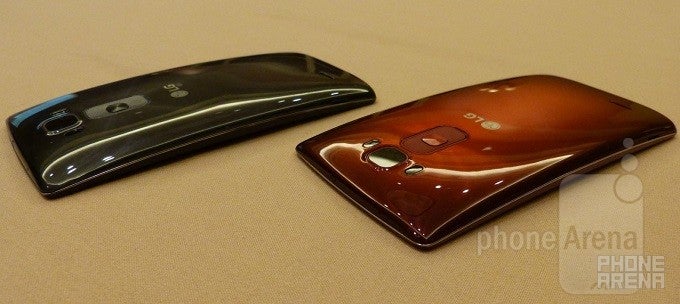LG G Flex 2 hands-on

LG introduced the world to flexible and “self-healing” smartphones a little over a year ago with the G Flex. The six-inch P-OLED display, while a little light on resolution, showed us that devices do not necessarily need to be ultra-rigid in an effort prevent breakage from being dropped.
As a first effort, the G Flex was also meant to be an indicator of where design trends eventually go with a lot of consumer products. Things start off square-ish, and as manufacturing methods progress and technology advances, edges get softer, corners rounded, and shapes become smoother.
Design
Given the “spin hairline” design of the back cover, and on-going curvature of the back, in addition to the G Flex 2’s existing curved build, we can tell you that this aesthetic enhancement exudes an elegant quality.
LG kept its trademark small bezels all around a very nice looking 1080p display, and other than the corners at the edge of the screen, there is not a sharp edge anywhere to be found on the G Flex 2. The curved chassis, accentuated by the rounded back plate, and very small bezels, made this new LG feel very comfortable to hold in the hand.
The dimensions of the G Flex 2 are very close to those of the LG G3, and it weighs the same at 152 grams. The G Flex 2 is 5.87 x 2.96 x 0.37 inches (149.1 x 75.3 x 9.4 mm), and just 0.27 inches (7.1 mm) at its thinnest point. The 3,000mAh battery will accept rapid charging courtesy of a beefy 2.6 amp, 15 watt, 9 volt charger. It should take less than 40 minutes to get a 50% charge.
The design of the LG G Flex 2 also packs goodies on the connectivity front too, with support for tri-band LTE-Advanced, Bluetooth 4.1, Wi-Fi a/b/g/n/ac, and NFC.
Display
The compact nature of the G Flex 2 belies the 5.5-inch full HD P-OLED display. The resolution is 1920x1080, and by all accounts on the pre-production units we got to examine, the displays look gorgeous.
The panel is protected by a chemically treated screen of Gorilla Glass 3. What LG did was buy finished products from Corning, then performed its own chemical reaction with the panels at high temperature.
The resulting product is claimed to be 20% stronger than Gorilla Glass 3, and flexible. Coupled with a chassis that does not mind being bent, the whole device abates any concentrated shock from an impact if dropped or stepped on.
Advanced Self-healing
The first generation G Flex introduced the world to a product that is able to self-repair light dings and scratches, such as what might be encountered in a pocket or purse. The healing process would take anywhere from 30 seconds to a few minutes depending on temperature.
Interface
The user interface of the LG G Flex 2 carries the renewed experience that was introduced with the LG G3, including the Smart Keyboard, and Smart Notice. Other features like being able to change the on-screen navigation keys are present too. The G Flex 2 will launch with Android 5.0, but it UI layer masks much of what may be familiar in a stock Android environment.
For those that like to take selfies, there is a new seamless gesture shot and view. Take a picture, and as you lower your arm, the G Flex 2 will show you the preview of the photo.
Another feature that was added is an ergonomic glance view. When the device is asleep, a quick slide down from the top, will reveal a peek at time and notifications.
Processor and Memory
Under the hood, the LG G Flex 2 is backing the goods. It will be one of the first smartphones to launch with a 64-bit octa-core Qualcomm Snapdragon 810 CPU, clocked at 2.0GHz. More than enough power to manage things.
There will be a 16GB model which would have 2GB of RAM, and a 32GB storage model with 3GB of RAM. The storage is expandable with microSD cards, accepting capacities up to 2TB.
Camera
LG received a lot of feedback about the camera on the first generation G Flex. For the G Flex 2, the company opted to use essentially the same unit found on the G3, then improved on the platform, driving home the point that it felt the camera was superior to the G3's in every way.
It is a 13 megapixel main camera with a dual-LED flash, laser auto-focus, and optical image stabilization plus (OIS+). On the front, the selfie/video chat camera is a 2.1 megapixel unit. The camera interface closely mirrors that of the G3 which may frustrate those that like to access manual controls, but again, these were pre-production units.
Expectation
The LG G Flex 2 brings to prime time the overriding form factor that the G Flex broke ground on. The more compact size is a reflection of the company listening to feedback from users who felt the first generation device was a bit too big. Not surprisingly, the upgrade in display resolution will certainly prove to be a welcome change.
Likewise, pricing was not announced either. If the G Flex 2 follows a similar model to the US release of the first generation device, it will land on at least two or three carriers, and it will likely carry a higher price tag, $300 on-contract, and a retail price north of $600.
As presented, the LG G Flex 2 holds all the goods to be a new flagship for the company if it so chose, screen resolution notwithstanding. We, like we suspect many of you, are simply left asking, “When? When? When? When? When?”











Things that are NOT allowed: